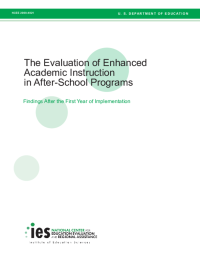The Evaluation of Enhanced Academic Instruction in After-School Programs
Findings After the First Year of Implementation
With the press to improve the achievement of children, educators are increasingly turning to after-school programs as a venue to provide supplemental academic support. The U.S. Department of Education’s 21st Century Community Learning Centers (21st CCLC) program, established in 1999, provides approximately $1 billion to states each year, with the primary purpose of providing opportunities for academic enrichment to help students meet state and local standards in core content areas. Many other after-school programs also provide various forms of academic support.
Findings from a previous national evaluation of the 21st CCLC program indicate that, on average, program grants awarded between 1999 and 2002 had a limited impact on elementary school students’ academic achievement. A possible factor is the finding that most academic activities at the evaluation sites consisted of only homework sessions in which students received limited additional academic assistance. Therefore, the low levels of formal academic assistance offered in these programs and the programs’ limited academic effects highlighted the need for improved academic instruction in after-school settings.
In response, the Institute of Education Sciences funded the development and evaluation of instructional resources for reading and math that could be used in after-school programs for elementary school students. This study tests whether such instructional approaches produce better academic outcomes than regular after-school services that consist primarily of help with homework or of locally assembled materials that do not follow a structured curriculum. The specific instructional approaches (developed by Success for All for reading and Harcourt School Publishers for math) were adapted from existing curricula used during the regular school day to reflect the particular needs of after-school programs: engaging materials that could be delivered in 45-minute modules that did not require students to attend the program every day.
This project tests one of many possible approaches for supplemental instruction (others might be more experiential or focused on enrichment). Furthermore, it is not a test of the effects of after-school program services compared to no after-school program. As part of the intervention, these instructional models were supported by implementation strategies related to staffing, training and technical assistance, and student attendance. This report presents findings, after one year of program implementation, from a two-year intervention and random assignment evaluation in 50 after-school center (25 for reading and 25 for math) for students in grades 2 through 5.
Key Findings for Math
In the first year of the study, the enhanced math model, Mathletics, had the following findings:
- The enhanced math program was generally implemented as intended (in terms of staff characteristics, training, and usage of instructional materials). As planned, the enhanced math instruction was offered an average of four times a week in 45-minute sessions. In over 90 percent of observed classes, instructors used the Mathletics materials and organized the transitions between the parts of the daily lesson as intended.
- Students attended an average of 73 daily sessions, which represented 30 percent more hours of math instruction over the school year, compared with students in the regular after-school program group.
- There are positive and statistically significant impacts for the enhanced math program on student achievement, representing 8.5 percent more growth over the school year for students in the enhanced program group, as measured by SAT 10 total math scores.
- The math program did not produce statistically significant impacts (either positive or negative) on any of the three school-day academic behavior measures: student engagement, behavior, or homework completion.
Key Findings for Reading
Adventure Island, the reading model put in place in 25 after-school centers, had the following first-year findings:
- The enhanced reading program was generally provided by the intended staff who received training and used the instructional materials. As planned, the enhanced reading instruction was offered an average of four times a week for 45 minutes a day.
- Some reading instructors reported that it was difficult to include all aspects of the reading program and maintain the intended pace of the daily lesson plan.
- Students in the enhanced program attended an average of 70 daily sessions, which represented 20 percent more hours of reading instruction over the school year, compared with students in the regular after-school program group.
- The students in the enhanced reading program did not experience a statistically significant impact on their performance on the SAT 10 reading test; there are positive and statistically significant program impacts on one of the two measures in the DIBELS fluency test.
- The reading program did not produce statistically significant impacts (either positive or negative) on any of the three school-day academic behavior measures: student engagement, behavior, or homework completion.
Next Steps
The project is continuing into a second year of implementation, data collection, and analysis. In this final phase of the project, the analysis will examine whether impacts produced in the second year of implementation are greater than those produced in the initial year and what the impacts are of offering students access to the program for two school years. A final report will be released in 2009.






